- Kenmore refrigerator water filters
- Whirlpool refrigerator water filters
- Samsung refrigerator water filters
- GE refrigerator water filters
- LG refrigerator water filters
- Frigidaire refrigerator water filters
- KitchenAid refrigerator water filters
- Maytag refrigerator water filters
- Kenmore Elite refrigerator water filters
- Estate refrigerator water filters
- GE Profile refrigerator water filters
- Amana refrigerator water filters
- Bosch refrigerator water filters
- Dacor refrigerator water filters
- Electrolux refrigerator water filters
How to replace a water inlet valve on a vertical modular top-load washer
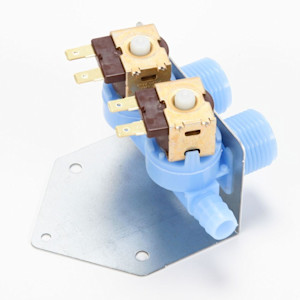
This step-by-step washer repair guide shows how to replace the water inlet valve assembly on a vertical modular top-load washer. Replace the inlet water valve with a manufacturer-approved washer part if the washing machine doesn't fill or if it fills with water even when the washer is unplugged.
This procedure is for Kenmore, Whirlpool, Maytag and Amana vertical modular top-load washers.
We also have instructions for replacing the water inlet valve on a front-load washer and a replacing the water inlet valve on a direct-drive top-load washer.
Quick links
Video
Instructions
Tools required
Channel lock pliers. 1/4" nut driver. Putty knife. Work gloves. Towel
Repair difficulty
Time required
30 minutes or less
Repair difficulty
Time required
30 minutes or less
Replacing the water inlet valve on a vertical modular top-load washer
This video explains how to replace the water inlet valve on a vertical module top-load washing machine.
Instructions
- 01.
Shut off the electricity and water
Unplug the power cord from the wall outlet. Turn off the water supply valves for the washer.
Wear work gloves.
Enlist an assistant to help pull the washer away from the wall.
- 02.
Disconnect the fill hoses
Move the washer so can you remove the fill hoses from the back of the washer.
Mark which fill hose goes to the hot connector and which goes to the cold before removing.
Using channel lock pliers, carefully loosen and remove both hoses. Expect some water to pour out.
Tip: Wipe up water spills with a towel to prevent slipping. - 03.
Release the control console
Use a 1/4" nut driver to remove the hex head screws from the back of the control console.
Push the control panel back and slide a putty knife under one corner.
Lift the panel and push with the putty knife blade to release the retaining clip.
Repeat the procedure on the opposite corner.

PHOTO: Remove the screws from the back panel of the console.
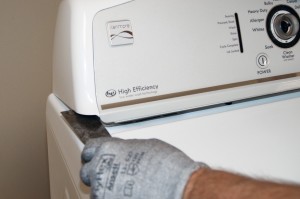
PHOTO: Slide a putty knife under one corner of the control panel console.

PHOTO: Release the clips that hold the console in place.
- 04.
Remove the water inlet valve's mounting screws
Tip the control console forward and rest it on the top of the washer.
Locate the water inlet valve assembly and remove the 2 hex-head screws that hold the valve.
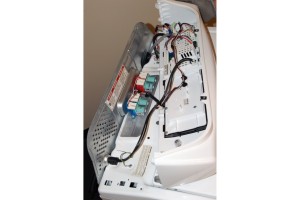
PHOTO: Tip the console forward and rest it on the top of the washer.
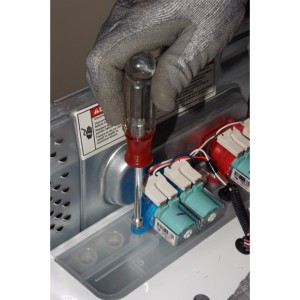
PHOTO: Remove the water inlet valve mounting screws.
- 05.
Detach the wire harness connections
Take a digital picture of the wiring connections or label them so you can reattach them correctly.
Pull straight back on the wire harness connectors to detach them from the solenoid coils.
- 06.
Remove the water valve
Pull the water valve out of the washer. Set it aside for disposal.
Tip: This style of washer doesn't have hoses connected to the water inlet valve. If your model has hoses, disconnect them by releasing the spring clamps. - 07.
Install the new water valve
Push the new water valve into position .
Checking your photo or labels for correct placement, push each wire connector fully onto the correct connector spade.
Reinstall the mounting screws. To avoid overtightening, turn each screw with the nut driver until it stops, then give the screw one firm twist to snug it in place.
- 08.
Secure the control panel
Position the console and snap the mounting clips into place. Insert the screws into the back panel and tighten firmly.
- 09.
Reinstall the fill hoses
Thread the fill hoses onto the connections on the back of the washer, checking that hot and cold lines are placed properly.
Tighten the connections firmly using channel lock pliers; don't overtighten, which could crack the plastic on the inlet valve.
- 10.
Restore the water and power
Turn on the water supply valves and check for leaks at the wall and the washer. Tighten the connection if you find a slight leak.
Plug the washer into the electrical outlet. Return the washer to its original location.
Warning: Undertaking repairs to appliances can be hazardous. Use the proper tools and safety equipment noted in the guide and follow all instructions. Do not proceed until you are confident that you understand all of the steps and are capable of completing the repair. Some repairs should only be performed by a qualified technician.
Most common symptoms to help you fix your washers
Choose a symptom to see related washer repairs.
Main causes: clogged drain hose, house drain clogged, bad drain pump, water-level pressure switch failure, bad control b…
Main causes: worn agitator dogs, bad clutch, broken motor coupler, shifter assembly failure, broken door lock, suspensio…
Main causes: bad lid switch or door lock, bad timer or electronic control board, wiring failure, bad water inlet valve a…
Main causes: broken lid switch or lid lock, bad pressure switch, broken shifter assembly, faulty control system…
Main causes: unbalanced load, loose spanner nut, worn drive block, broken shock absorber or suspension spring, debris in…
Main causes: no water supply, bad water valves, water-level pressure switch failure, control system failure, bad door lo…
Main causes: lack of electrical power, wiring failure, bad power cord, electronic control board failure, bad user interf…
Main causes: leaky water inlet valve, faulty water-level pressure switch, bad electronic control board…
Main causes: water heater failure, bad water temperature switch, faulty control board, bad water valve, faulty water tem…
Repair guides for top-load washers

How to replace the motor coupler on a top-load washer
If the washer drains but won’t agitate or spin, the motor coupler might have broken to protect the drive motor from dama…
Repair difficulty
Time required
60 minutes or less
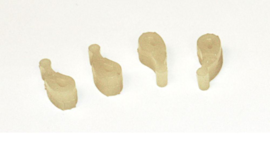
How to replace the agitator dogs in a top-load washer
If the top of the agitator moves both ways instead of just one, replace the agitator dogs, using the steps in this repai…
Repair difficulty
Time required
15 minutes or less
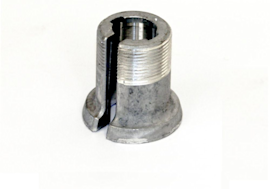
How to replace the drive block on a top-load washer
The drive block rotates the spin basket. If the basket wobbles or rattles in the spin mode because the drive block is wo…
Repair difficulty
Time required
60 minutes or less
Effective articles & videos to help repair your washers
Use the advice and tips in these articles and videos to get the most out of your washer.

We've put together some tips on keeping your washing working well.…
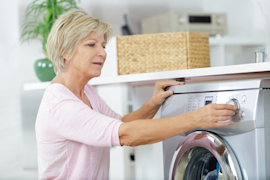
Find tips for using your washing machine efficiently to save energy and help reduce utility bills.…

Learn about all the convenient features on our Sears PartsDirect website that make your parts purchases easier.…